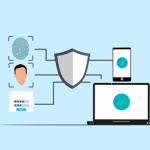
How about this as New Year’s resolution for your business? Clean up all the garbage that clogs up your network! If you use a good Managed IT Services firm, you’re probably in good shape, but if you’re still relying on haphazard IT Support (like your college-age nephew) you’ve probably got a lot of junk in that trunk.
Your business network is the lifeblood of your operations – and your success. It's the digital artery that pumps data through your organization, enabling everything from email to critical applications and cloud services.
When downtime hits, the consequences can be catastrophic. Communication is cut off and productivity grinds to a halt. Additionally, it can leave your customers hanging and unhappy and dry up revenue streams. This is the stark reality of network downtime.
When your system goes down, it’s important to identify the source as fast as possible. Understanding the issue can save you time, money, and countless headaches. Let's get started on keeping your network up and running smoothly. Read on for
Here are some helpful tips to troubleshoot common business network issues.
1) Identify the Problem
This is always the first step - understanding the nature of the problem. By gathering detailed information, you can narrow down potential causes.
Learn the Scope of Damage
Is the outage affecting a single user, a group of users, or the entire network? This helps you zero in on the cause, and potential solutions.
If only one user is down, it might be a device problem, perhaps even a cable gone bad. If the entire network is down, it’s definitely a more significant issue.
Investigate
Query the affected users with specific questions about the problem. When did it start? What were they doing when it happened? Have they tried any solutions? Gathering detailed information helps pinpoint the cause.
Check Any Error Messages
Often, these problems are accompanied by error messages or alerts. These can provide clues about the nature of the issue. Document these messages for future reference.
2) Check the Physical Connections
Has a cable been kicked loose? Physical connections are often overlooked, but they are the first place to look. But they can be a common cause of network issues. Check cables, ports, and power sources. Ensure that cables are securely connected and undamaged. A loose or damaged cable can cause connectivity issues. Test cables with another device to confirm they work correctly.
Once you rule those out, go on to the next most obvious cause.
Verify Power Sources
Even though an affected computer has power, make sure that all networking equipment has power. Check power cables and adapters. Sometimes, a simple power issue can cause network problems. Reset power sources if necessary.
Inspect Network Devices
Next, go beyond the computer and check routers, switches, and modems. Ensure they are functioning correctly, and all lights show normal operation. Restart these devices to see if it resolves the issue. Sometimes, a reboot can clear temporary glitches.
3) Check Network Connectivity
It may be simpler to identify where the connection fails once you test network connectivity and whether the issue is device-specific or network-wide. Using simple tools and tests can provide valuable insights into the problem.
Ping and Traceroute
One good way to check to test network connectivity is to use ping and traceroute commands. These tools help identify where the connection fails. For example, if ping works locally but not remotely, the issue might be external.
Test Different Devices
Interchange devices to test the network. This helps determine if the issue is device-specific or network-wide. Does one device connect successfully while another doesn’t? Then the problem might be with the device, not the network.
Examine Wi-Fi Signal Strength
When Wi-Fi fails, kit drags everything with it, so check the signal strength. Weak signals can cause connectivity issues. Move closer to the router or access point and see if the connection improves. Consider using Wi-Fi analyzers to identify signal strength and interference.
4) Double-Check Network Configuration
Problems with network configuration can go unnoticed until there’s a bottleneck causing a logjam, at which point they can cause connectivity issues. Check IP settings, DNS settings, and configurations on routers and switches. This can help you identify and resolve misconfigurations. Some of these are a bit technical. They might need the help of an IT services partner.
Check Your IP Settings
On affected devices, verify IP settings. Ensure devices have the correct IP addresses, subnet masks, and gateways. Incorrect settings can prevent devices from connecting to the network.
Inspect DNS (Domain Name System) Settings
Incorrect DNS settings can cause problems with accessing websites and services. Use reliable DNS servers and ensure settings are correctly configured.
Examine Router and Switch Configurations
If there are incorrect settings or misconfigurations on routers and switches, connectivity problems arise. Check for any changes that might have caused the issue.
5) Monitor Network Performance
Network performance should be monitored on an ongoing basis. This helps identify ongoing issues and potential bottlenecks. There are many tools you can use for this purpose. They also help pre-warn you of network issues.
Network Monitoring Tools
If you don’t have them, install network monitoring tools to track performance. These tools provide insights into network traffic, bandwidth usage, and potential issues. They help identify trends and pinpoint problem areas.
Find Any Bottlenecks
High traffic or heavy usage can bottleneck and slow down the network, so search out and adjust any network bottlenecks. Consider upgrading bandwidth or optimizing traffic flow to ease congestion.
Search for Interference
Look for interference sources in wireless networks. Other electronic devices, walls, and even microwaves can interfere with Wi-Fi signals. Use different channels or frequencies to reduce interference.
Security and Updates
This should be a no-brainer by now: keeping your network secure and up to date is crucial for smooth operation. Make sure that all networking equipment has the latest firmware and software updates. Updates often include bug fixes and performance improvements. Regular updates help maintain a stable and secure network.
Regular Malware Scans
You should already be running regular malware scans on all devices. Malware can cause various network issues, including slow performance and connectivity problems. Use reputable antivirus software and keep it updated.
Evaluate Current Security Settings
Examine the security settings on routers and firewalls. Ensure proper configurations and that no unauthorized changes have occurred. Strong security settings help protect the network from external threats.
Due Diligence
The above are not new, earthshaking concepts – these simply constitute the basic due diligence that should be performed by anyone who wants a fast, reliable network.
Frequently Asked Questions
What is the main cause of system downtime?
Generally, it’s caused by hardware or software failure, but downtime can be due to human error, malicious attacks or natural disasters. Since unplanned downtime is (of course) unexpected and occurs without a warning, preventing it can be a challenge. Good all-round network hygiene and security provides a good start.
What is the average cost of downtime?
A widely cited Gartner study cites the average cost of network downtime at around $5,600 per minute, although it depends on the industry. The cost can be more in higher-risk enterprises like healthcare and finance.
What is the most popular network monitoring program?
The CTO Club offers these as the top 5:
LogicMonitor — Best for cloud-based network monitoring.
Netdata — Best for real-time infrastructure monitoring.
WhatsUp Gold — Best for comprehensive network monitoring.
Datadog — Best for small businesses.
Zabbix — Best open-source option.
How to run troubleshooter for Wi-Fi?
For a PC network, Microsoft provides these steps:
“Select the Start button > Settings > Network & Internet > Status. Under Change your network settings, select Network troubleshooter.”
How secure is your network?
As a reputable member of the IT Support Los Angeles community since 2002, IT Support LA offers a FREE, no-risk network and security assessment. It is a non-intrusive scan that allows us to deliver a comprehensive report that is yours to keep. No strings, and no obligation to ever use our Managed IT Services.
The best defenses are expert cybersecurity to protect your data from theft, and a top-notch Managed Services Provider (MSP) to ensure continued reliability and defenses against newly emerging threats.
With our 100% Money Back Guarantee in writing, we offer a risk-free way for prospective clients to try us out. Because we do not require a ‘hard’ contract, our clients can fire us at any time with 30 days’ notice. We have to be good.
Among the Managed IT services we provide:
IT HelpDesk Service
Onsite IT Support
Cybersecurity
Cloud migration and management
Email migration services
Backup and disaster recovery
VoIP phone systems
IT disposition and recycling
Office moves
White label services (IT to IT)
IT Support LA is an award-winning Managed Services Provider (MSP):
o 3 Years awarded Best IT by the Small Business Expo
o Awarded 2nd best company of any type in the US by the Small Business Expo SB100
o Awarded Best IT Support in California by Channel Futures
o Winner of Best IT in Los Angeles by Channel Futures
o Listed as one of the world’s Top 501 Managed Services Providers by CRN and in the top 250 in the ‘Pioneer’ listing
o 4 years listed as one of the Top 501 Managed Services Providers in the World by Channel Futures
o Listed as #21 Managed Services Providers in the World in Channel Futures NextGen 101
o Globee 2021 Bronze Award winner for Chief Technology Officer of the Year
o Globee 2022 Gold Award winner for Chief Technology Officer of the Year
o Named one of 2022’s 50 ‘Best’ businesses in California by UpCity
o Named Best of IT winner by UpCity
o Winner of Local Excellence Award for 2021, 2022 and 2023 by UpCity
o Named Best of Cloud Consulting winner by UpCity
o Certified as Top Managed Services Providers and Cybersecurity Pro by UpCity
o Named Best IT in Los Angeles by Expertise.com.
Want Help Optimizing Your Business Network?
A reliable network is essential for business operations. Avoid costly downtime issues by working with our team to keep your network in top shape. We can put in place monitoring and other best practices. We’ll ensure your network runs smoothly and fully supports all your needs.
Contact us today to schedule a chat and take advantage of our FREE no-risk network and cybersecurity assessment.
818-805-0909


